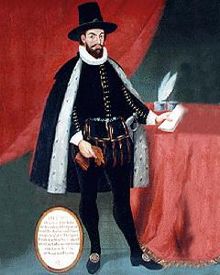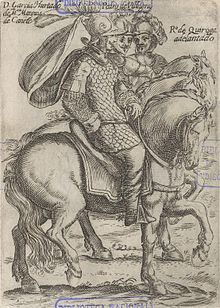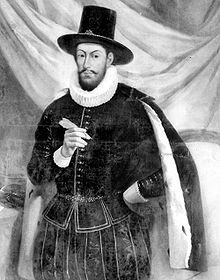- García Hurtado de Mendoza, 5th Marquis of Cañete
-
Don
García Hurtado de Mendoza
Marqués de Cañete
Caballero de SantiagoRoyal Governor of Chile In office
1557–1561Monarch Philip II Preceded by Francisco de Aguirre Succeeded by Francisco de Villagra Viceroy of Peru In office
January 8, 1590 – July 24, 1596Monarch Philip II Preceded by Fernando Torres de Portugal Succeeded by Luis de Velasco Personal details Born 21 July 1535
Cuenca, SpainDied 19 May 1609 (aged 73)
Madrid, SpainSpouse(s) María Manrique Children García Hurtado de Mendoza Religion Catholic García Hurtado de Mendoza y Manrique, 5th Marquis of Cañete[1] (July 21, 1535 – May 19, 1609) was a Spanish soldier, governor of Chile, and viceroy of Peru (from January 8, 1590 to July 24, 1596). He is often known simply as "Marquis of Cañete".
Contents
Early life
He was the son of Andrés Hurtado de Mendoza, 3rd Marquis of Cañete — also a viceroy of Peru — and Magdalena Manrique, daughter of the Count of Osorno. Both his parents belonged to some of the most important families in the Spanish aristocracy.
In 1552 Hurtado de Mendoza ran away from home with the intention of serving his king, Charles I (Emperor Charles V), in an expedition he was preparing against Corsica. He demonstrated great valor in this campaign and also in Tuscany, when that duchy attempted to throw off Imperial rule. He was part of the Imperial army in Brussels, and was with Charles V during his defeat in the Battle of Renty.
Upon learning that his father had been designated viceroy of Peru, he returned to Spain and asked to be sent to America. During the journey he met Jerónimo de Alderete, who had been chosen by the king to be the successor of Pedro de Valdivia as governor of Chile. It happened that Alderete became sick and died during the trip. Hurtado's father gathered together a group of Chilean representatives, and, finding that they could not agree on whether Francisco de Aguirre or Francisco de Villagra was more qualified as a successor for the post, put forward his own son. He hoped that his son would bring more Spaniards to Chile, and additionally be able to unify the two camps in the battle for the post of governor of Chile. And he hope he could deal successfully with the rebellious Indians.
Thus Hurtado left for Chile, 21 years old, with proven bravery. He was haughty, proud of his lineage and intelligence, authoritarian in outlook, and subject to violent outbreaks. His character made enemies, mostly hidden, within his own circle.
Governor of Chile
Hurtado de Mendoza left Peru for Chile at the head of a force of 500 Spaniards. A part of this force traveled overland under the command of Luis de Toledo and Pedro de Castillo. This group left in January 1557. The other part, under the command of the new governor, traveled by sea, leaving in February of the same year. The viceroy gave a banquet for his son, after which the fleet left port to the sound of military marches and a salute of cannons.
Hurtado de Mendoza sailed with an entourage of illustrious men, including Alonso de Ercilla y Zúñiga, Francisco de Irarrázaval y Andía, Fráncisco Pérez de Valenzuela, Friar Gil González de San Nicolás, the Franciscan Juan Gallegos and the learned jurist Hernando de Santillán. The expedition stopped in Arica on April 5, 1557 and remained there until the ninth of that month.
Continuing the voyage to the south, they disembarked at La Serena on April 23, 1557. The poor people of Coquimbo were amazed at the largest continent of soldiers — more than 500 — ever seen in those parts, armed with harquebuses and canons, wearing armor and crests of plumes. They soon acquired the nickname of emplumados (feathered ones).
Francisco de Aguirre and Francisco de Villagra
Francisco de Aguirre received the new governor hospitably in La Serena. At about the same time, Francisco de Villagra arrived in La Serena by land. Knowing the animosity between Aguirre and Villagra over their aspirations to the governorship of Chile, García Hurtado did not hesitate to take both of them prisoner in La Serena, isolating them on a ship. This act was considered very unjust by the Spanish settlers in Chile.
Mariño de Lobera relates in his chronicle that Aguirre, already aboard, greeted Villagra upon his arrival, shook his hand, and said:
-
See, Your Honor, Señor General, how are the things of the world: Yesterday the two of us did not fit in one large kingdom, and today Don García has made us fit on a single plank.
The governor arrived at Santiago as winter approached. The cabildo (city council) was making preparations to welcome him, but Hurtado decided to continue by sea to Concepción, in spite of the contrary advice of those who knew the dangers of the climate at this season. At Coquimbo he sent the cavalry on by land. Hurtado sailed on June 21, 1557, in full winter.
Relations with indigenous peoples
He arrived eight days later in the bay of Concepción in the middle of a dangerous season. During a torrential rainstorm the troops disembarked on the island of La Quiriquina and erected a provisional encampment. Once settled in Concepción, Hurtado attempted a policy of good will towards the Indians, who had accepted the rule of the governor but were not ready to accept the occupation of their territories by the newly arrived Spaniards.
Lincoyan and other Indigenous leaders knew that the cavalry was coming by land from Santiago and conceived a plan to attack them at Andalicán, near Concepción. Hurtado learned of the Indigenous plan and was informed that the Mapuches interpreted his attitude as a sign of weakness and fear; he decided therefore to radically change his attitude toward them.
He ordered that the fort of San Luis de Toledo be built immediately in Araucana to frustrate the Indigenous initiative, but the fort was soon attacked by the Mapuches. They were defeated, and the governor counterattacked with his cannons and harquebuses.
He ordered a new campaign in October 1557, with a strong force of 500 soldiers and thousands of Indian auxiliaries. The Battle of Lagunillas occurred during this campaign, on November 7. In this battle the Spanish survived largely because of the valor demonstrated by Rodrigo de Quiroga and the other captains. The Mapuches showed themselves disorganized in the attack, and this disorder produced bad tactics that prevented a victory.
According of Alonso de Ercilla, who had arrived in Chile with the governor, the Spanish took prisoner the Indigenous leader Galvarino and cut off his left hand. He lost the hand without a grimace of pain and then extended the other, which the Spanish also cut off. He asked for death, but the conquistadors let him go. He left with his men, planning his revenge.
Galvarino ordered a new attack on the invaders on November 30. This was the Battle of Millarapue, in the valley of the same name. There were many fortuitous events in this battle that facilitated the surprise attack. Nevertheless, the Mapuches were defeated again, and as punishment 30 of them were hanged by the Spanish, including Galvarino, who had fought always in the first line.
The hardships of the struggle began to bother the companions of Hurtado, who had hoped to gain riches for their services. In order to redistribute them to his followers, the governor declared the encomiendas of Concepción vacant. For this reason, the city was refounded for a third time. A short time later, the city of Cañete de la Frontera was also founded, and was also divided among the troops returning from the battle.
The Mapuche leader Caupolicán, instigated by the Indian Andresillo, decided to attack Fort Tucapel. What he didn't know was that Andresillo was a traitor who communicated the details of the attack to the Spanish, so that the attackers were transformed into the attacked. The result was a flight by the Indigenous, who left behind many dead and wounded, and a serious weakening of the Indigenous forces.
The morale of the Spanish rose. In a surprise assault on the encampment of Caupolicán, they were able to capture him. He was conducted to Fort Tucapel. Some historians claim that he tried to deal with the Spanish, promising to convert to Christianity, but Alonso de Reinoso, the commander of the fort, condemned him to death by impalement.
In another battle, the Indigenous built a fort at Quiapo, between Cañete and Arauco, but they were again defeated in the Battle of Quiapo. The city of Concepción and fort Arauco were rebuilt in 1559. Other forts were founded, with the name of San Andrés de Angol, or Los Infantes and fort Talcamávida in 1560 and on the other side of the Andes the city of Mendoza in 1561.
Aftermath of the war
At this time, Hurtado de Mendoza was despised by those he had robbed. His wrathful character and his pride gained him many enemies, including Hernando de Santillán. Santillán had established the Tasa de Santillán, which regulated Indian servitude, permitting many Spaniards to abuse the Indigenous. It planted the seeds of future rebellions, in particular that of the Huilliches.
Sometime later, the governor was informed that his father the viceroy had been replaced by the king and that Francisco de Villagra had been designated governor of Chile. Hurtado expected to receive the same humiliations from Villagra that he had inflicted upon him, and for this reason he decided to leave Chile quickly. He first went to Santiago, a place he had not visited during his government.
In Santiago he was informed of the death of the successor of his father. This meant that his father would continue as viceroy, at least temporarily, and for that reason Hurtado decided to stay on as governor. He remained in the capital and took the opportunity to have a gentlemanly interview with Villagra about the state of the colony. Villagra did not humiliate him as he expected, receiving him with a cold but polite demeanor.
During his stay in Santiago the Tasa de Santillán was published. It established the system of mita (forced Indigenous labor). Instead of requiring labor from all the Indians in a village, this system established a rotation of servitude, obligating the chief of each tribe to send one man of each six to work in the mines, and one of each five to work in the fields. These workers, who up to now had been unpaid, were to be remunerated with a sixth part of the product of their labor, and this salary was required to be paid regularly, at the end of each month. Females and males under 18 years of age or over 50 were exempt from the mita, and it was ordered that the Indigenous be fed, maintained in health, and evangelized by the encomenderos (Spanish holders of the encomiendas).
Hurtado de Mendoza received news of the impending death of his father. He decided to leave immediately for Peru, designating Rodrigo de Quiroga interim governor (rather than Villagra).
Juicio de residencia
In Peru he was subject to a juicio de residencia for the arbitrary actions of his government in Chile (the confiscation of the encomiendas, the mistreatment of the soldiers, etc.). He was the first governor of Chile whose performance was judged under the laws of Spain. The tribunal found him guilty of 196 charges, but it left formal sentencing to the Royal Audiencia of Lima. The sentence was that he be detained within the city of Lima, until he was absolved of all accusations or he paid the fines to which he was condemned.
Return to Spain
However, Hurtado de Mendoza had already left Peru for Spain, to give his account of his campaigns and his government to King Philip II and the Council of the Indies. The prestige of his family, the information about his services given by the Audiencia of Lima, and the recommendations from some faithful captains that began to arrive from Chile caused the accusations of his enemies to be soon forgotten. Besides, he was recognized as the winner of the War of Arauco. This belittled the old conquistadors with the false claim that they had not done enough to suppress the Indian rebellions and pacify the Araucanía.
In Madrid he entered into the Royal Guard. He was also representative to the king in Milan.
Viceroy of Peru
In 1590 Hurtado returned to America, now as viceroy of Peru, a position he held until the middle of the following decade. It was a great help to the Spanish in Chile to have someone with his first-hand knowledge of that region in the position of viceroy.
Hurtado had frequent disagreements with Turibius de Mongrovejo, Archbishop of Lima, whenever civil and ecclessiastical jurisdiction conflicted. The seminary school established by Mogrovejo was not established without a fight over whether to put the bishop's coat of arms on top of the entrance, or the royal coat of arms in the same place, as well as during the excommunication of Juan Ortiz de Zárate, mayor of Lima, over the forced arrest of a criminal who had taken refuge at a church.
At the end of his term, Hurtado left Lima to return to Spain, where he died in 1609.
Ancestry
8. Honorato de Mendoza 4. Diego Hurtado de Mendoza
2nd Marquis of Cañete9. Francisca de Silva 2. Andrés Hurtado de Mendoza
3rd Marquis of Cañete10. Andrés de Cabrera
1st Marquis of Moya5. Isabel de Cabrera 11. Beatriz de Bobadilla 1. García Hurtado de Mendoza 12. Pedro Fernández Manrique
2nd Count de Osorno6. García Fernández Manrique
3rd Count of Osorno13. Teresa de Toledo 3. Magdalena Manrique 14. Alvaro de Luna
2nd Lord of Fuentidueña7. María de Luna 15. Isabel de Bobadilla Additional information
Notes
Sources
- Castro Pereira Mouzinho de Albuquerque e Cunha, Fernando de (1995) (in Portuguese). Instrumentário Genealógico - Linhagens Milenárias. pp. 329–30
- Hobbs, Nicolas (2007). "Grandes de España" (in Spanish). http://grandesp.org.uk/historia/titulos/titintro.htm. Retrieved 15 October 2008.
- Instituto de Salazar y Castro (in Spanish). Elenco de Grandezas y Titulos Nobiliarios Españoles. periodic publication
Categories:- 1535 births
- 1609 deaths
- People from Cuenca
- Viceroys of Peru
- Royal Governors of Chile
- Spanish nobility
- Marquesses of Cañete
- Knights of Santiago
- Spanish generals
- Hurtado de Mendoza
- Spanish explorers
- People of the Arauco War
- 16th-century Spanish people
- 17th-century Spanish people
-
Wikimedia Foundation. 2010.




